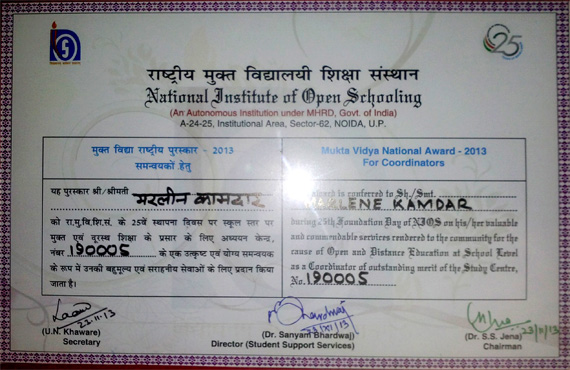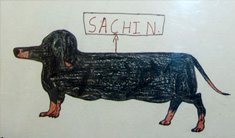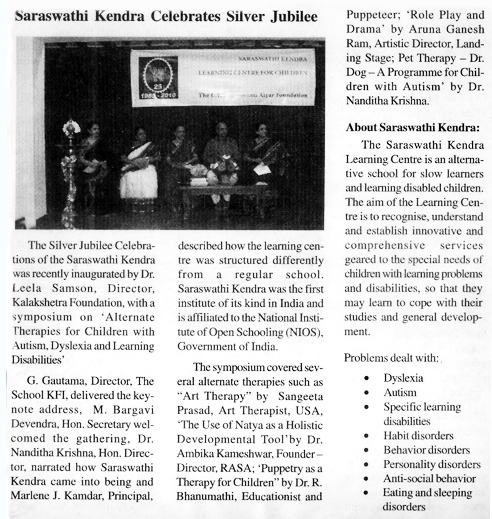 |
| |
.jpg) |
| |
 |
| |
 |
| |
 |
| |
 |
| |
 |
| |
 |
| |
 |
| |
 |
| |
The group you are viewing is a local
part of the Best Friends Network.
Home » Go Local » International » News » India: Chennai: "What did you have for breakfast today?"
News |
| |
India: Chennai:
"What did you have for breakfast today?" |
| |
February 17, 2010, 10:52PM MT
By Sharon St Joan, Best Friends Network |
| |
 |
| |
| Moosa takes his profession very seriously. He is a Dr. Dog, at the Saraswathi Kendra School in Chennai, and as he goes along the line of children, |
| |
| he greets each one by lifting his paw for a handshake. Naturally, each child responds by shaking his paw. |
| |
| Originally, Moosa came from Dubai, with one of his siblings, Sherry. His name means Moses. Both arrived as young dogs needing a home, who were first taken in by the organization Blue Cross of India, the first of the modern-style animal shelters established in India. It seemed a pity to separate them so they stayed together. Moosa’s sister Sherry was diagnosed with a heart problem and stays at home while Moosa visits his students. |
|
|
| |
In 2001, Jill Robinson, of Animals Asia Foundation in Chengdu, China, arrived for a visit in Chennai. Soon she had passed on to Dr. Nanditha Krishna, Honorary Director of the C P Ramaswami Aiyar Foundation, the concept and the knowledge needed to start a Dr. Dog program for the children at the school—especially how to assess the dogs and then train them. |
| |
The Saraswathi Kendra School is just one of several schools in India that are part of the C P Ramaswami Aiyar Foundation’s work. This particular school does an amazing job enabling autistic children and others with learning difficulties to go on to lead useful, productive lives.
|
| |
| First Words |
Vishal, a nine year old boy who had never spoken said the first words he’d ever said in his life to Sachin (named by the children after an Indian cricket player)—one of the Dr. Dogs at the school. |
| |
Uppuma is a south Indian dish made of vegetables. One day during a therapy session, Vishal turned to the dog and said, "Sachin, I ate uppuma for breakfast today, what did you eat?" |
| |
 |
Both the therapist and Sachin’s handler were astonished at this complex sentence spoken by a child who had never before uttered a single word to anyone. |
| |
Two years later, following many more sessions and a lot more schoolwork, Vishal wrote the following about Sachin, "Sachin is a little Dachshund…He has a beautiful black body with brown paws and a brown nose. Sachin has a body like a sausage with short tiny |
|
|
legs and a thin little tail. He has beautiful long floppy ears. …We love Sachin very much. He plays with the ball sometimes. He is very lively and he runs very fast. He is a very special dog because he helps children who are shy and backward to behave with confidence. We play with him for one hour every day during Pet Therapy class." |
| |
Vishal is not the only child at the Saraswathi Kendra School who has spoken his or her first words to a dog. There are several others. As we all know, dogs are non-judgmental and easy to relate to. As our best friends, they make it easy to communicate. "A dog is non-threatening," Dr. Nanditha Krishna says. |
| |
A few of the children have come from abusive situations, where trauma may have led to their inability to speak, so Dr. Dog is a friend that they can trust. |
| |
| Moosa speaks English |
| |
The Pet Therapy sessions always include a dog handler for the dog and a trained psychologist as the therapist. Each session is limited to two or three children and takes place in a separate building where there are fewer distractions. |
| |
The children are introduced to Moosa and are told that he knows English and that they will need to speak with him in English. Speaking English is encouraged since it will help them to find a good job after they finish school. |
| |
 |
Although some students who are better suited to other educational programs are referred elsewhere, no child is ever turned away from the Saraswathi Kendra School because of an inability to pay. Some of the children’s families pay the full fees, and others pay much less. Some are not able to pay at all. Only the principal and two or three of the senior staff know which children come from families that are paying tuition and which do not, so all of the children are treated equally. The CP Ramaswamy Aiyar Foundation |
|
|
also runs the Grove School in the building next door. An upscale school for children from well-to-do families, the Grove School generates income to pay the scholarships for the children of the Saraswthi Kendra School whose families do not have the resources to pay. So a great many children are given an excellent education, and the schools are self-sufficient and pay for themselves. There is a plan to merge the two schools in the future. |
| |
| Finding the child’s potential |
| |
| This summer, they’ll be celebrating the 25th year of the Saraswathi Kendra School. It started 1994 with two children, a desk, and a teacher. Now 500 students have graduated from the school. The graduates have progressed from being children who had very few options in life because they had autism or learning difficulties, to being people who are now able to lead very successful lives. Notable among them are a number of well-known sports stars and commercial artists, as well as many who excel in other fields.
Dr. Krishna explains, "We find out what the child as the potential to become, and then those are the qualities that we bring out in the child." |
| |
| An environmental emphasis is a major focus of the school. They have a nature club. They go to the Guindy Reserve Forest in Madras for birdwatching. |
| |
This year the Grove School has done a project on the rivers of India, which the Saraswathi Kendra School also participated in. In a class called Indian Culture, they have kept scrapbooks. They talk about Indian traditions. For example, they examine the cultural reasons for vegetarianism. They look at why Ahimsa (the Indian tradition of doing no harm) is practiced. |
| |
| Every morning during prayers the children sing, |
| "I bow to my mother, |
| The land of beautiful waters, beautiful fruits, the cool breeze of the mountain. |
| It’s green everywhere; |
| I bow to my motherland. |
| |
| They give thanks for their parents and teachers, and they recite an ancient prayer: |
| |
| "Lead me from the unreal to the Real; |
| Lead me from darkness to Light; |
| Lead me from death to Immortality." |
| |
| Moosa smiles and shakes their hands. |
| |
| To learn more about the Saraswathi Kendra School, or the CP Ramaswamy Foundation, please click here. |
| |
To learn more about the Dr. Dog program of the Animals Asia Foundation in China, please
click here. |
| |
To visit the website of Blue Cross of India, please
click here. |
| |
| Photos: Sharon St Joan |
| |
Top photo: Moosa, with Dr. Nanditha Krishna
Second photo: A drawing of Sachin by Vishal
Third photo: Shyama lives (as do Moosa and Sherry) with Dr. Nanditha and Dr. Chinny Krishna, as one of their thirteen rescued dogs. All are mixed breeds except for two.
Shyama likes to be in charge to ensure that everyone behaves properly.
http://network.bestfriends.org/golocal/international/14456/news.aspx
http://network.bestfriends.org/golocal/india/14456/news.aspx |
| |
 |
| The Hindu, 13th September, 2009 |
| |
 |
 |
| 8th September, 2009 |
Times City 5th September, 2009 |
|
| |
 |
| Padam Health News, 1st August, 2009 |
| |
 |
| Chennai City, The Hindu, 13th July, 2009 |
| |
 |
| Mylapore Times, July 12 " 2009 |
| |
 |
| July 10, 2009 |
| |
 |
| Mylapore Times " July 11 " 17, 2009 |
| |
| Doctor Dog |
| |
| By Anusha Parthasarathy |
| |
 |
| |
Dr. Moosa is a regular at Saraswathi Kendra Learning Centre for Children. As he enters the class, the children crowd around him, excited and a little scared. He sits down and waits patiently as they approach him. "Hi! My name is Ashok," one of the boys says shyly, adding "I like dosa. Do you like dosa?" Moosa holds out a paw and someone at the back says, "He likes Dosa too." |
| |
Dr. Moosa is a black Labrador. Saraswathi Kendra Learning Centre for Children, a part of the C.P. Ramaswami Aiyar Foundation, is India’s first full-time school for children with autism, learning disabilities, dyslexia and behaviour and habit disorders. It provides a range of innovative therapies for its 175-odd students and one of it is animal-assisted therapy for autistic children. And what better animal to work with than man’s best friend? |
| |
"Autistic children have an inability to communicate verbally and concentrate on one particular thing. Some of them never talk. But when there is a dog, they feel a lot more at ease. We talk through the dog and encourage the children to reply. This not only improves their verbal communication but they also learn to concentrate. We have found it to be more effective than traditional therapy," says Marlene J. Kamdar, the principal. Dr. Dog has been around for 13-odd years and remains a highly successful method even today. |
| |
Dr. Moosa is the seventh on call. One among the therapy’s best success stories hangs in the front office of the school in the form of a framed chart with the childish drawing of a Dachshund, 10 scrawling lines written in sketch pen describing it and ‘Pet Therapy with Sachin" written in big bold letters at the top. "Sachin is a little Dachshund puppy" He has a body like a sausage…" it goes. It was written by an autistic boy who, after nine years of silence, spoke about Sachin the first ever time he spoke. |
| |
"You can’t have this kind of success with other animals. But even with dogs, the best breeds to work with are Labradors and retrievers. They’re naturally friendly dogs. The smaller breeds are unpredictable and though we did work with two Dachshunds, labs are the best," Dr. Nanditha Krishnan, Hon. Director, CPR Foundation, says. |
| |
Dr. Dog sessions are two times a week for about 45 minutes. It is on a one-on-one basis and the dog works with three or four kids every class. During the course the student works with dogs in a planned way to increase desirable abilities. |
| |
Saraswathi Kendra, in association with Blue Cross, certifies these dogs and trains them for use in other special schools across the city. |
| |
"We encourage volunteers too. People can bring in their dog to work with us for the Dr. Dog programme. The dog has to be minimum two years old, healthy, vaccinated and must have basic obedience skills. A lot of people have volunteered in the past but they drop out soon because we insist that the dogs have to be sterilised to prevent aggression. But it’s imperative because one mistake could cost the dog and the child their life," Nanditha explains. |
| |
As Dr. Moosa leaves the class, the kids protest for a few minutes and then watch as their doctor is led away by his handler. "This helps them learn to let go," Nanditha concludes, adding, "But I must tell you that there is something about a dog that makes the child talk. No one knows how or why. But it just happens." |
| |
| http://www.goergo.in/?p=4521 |
| July 9, 2009 |
| |

